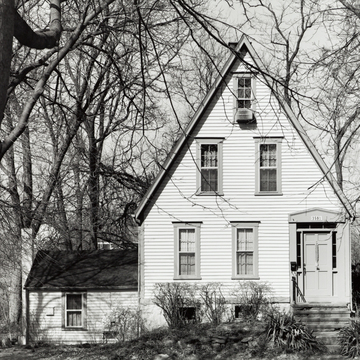Diagonally across the street is an example of a rare house type, a so-called lightning splitter. It takes its name from the exceedingly steep pitch of the roof on a narrow house, which, according to jocular myth, would split the bolt that hit it—although the story does not go on to tell us how this feat might save the house. A purer variant of the precedent, minus the myth, continues to the present in the A-frame, for the practical reason that it is an economical means of obtaining space with simple framing, although at some inconvenience from excessive interference from eaves inside. Joseph Bicknell married Pearce Allin's daughter Louisa from across the street in 1827, and the house was allegedly her father's wedding present. But stylistically the date seems early for a house of this appearance. Is the roof form, then, the result of a later remodeling when Dr. Armington and his wife, a younger Allin daughter, moved into the house in 1850? In any event, the charm of the “lightning splitter” is its exaggeration of the simple gabled box of the childhood image for “house.” This and the Daniel Pierce House in Providence (see entry) seem to be the finest examples of the type in the state.
You are here
Joseph Bicknell–Dr. Hervey Armington House
If SAH Archipedia has been useful to you, please consider supporting it.
SAH Archipedia tells the story of the United States through its buildings, landscapes, and cities. This freely available resource empowers the public with authoritative knowledge that deepens their understanding and appreciation of the built environment. But the Society of Architectural Historians, which created SAH Archipedia with University of Virginia Press, needs your support to maintain the high-caliber research, writing, photography, cartography, editing, design, and programming that make SAH Archipedia a trusted online resource available to all who value the history of place, heritage tourism, and learning.

